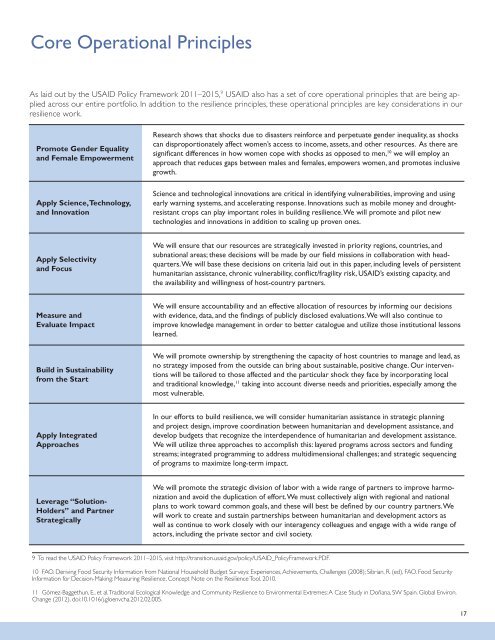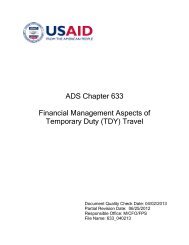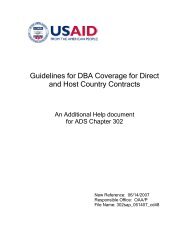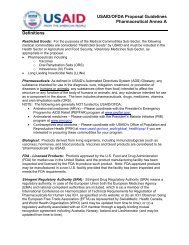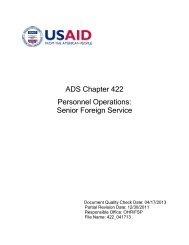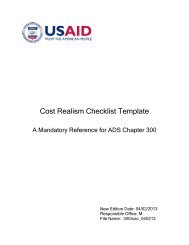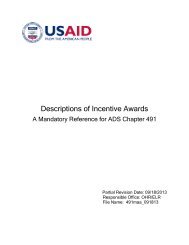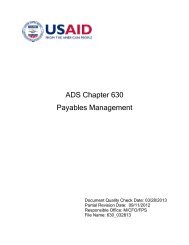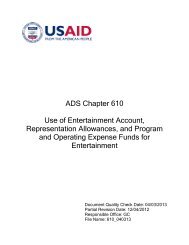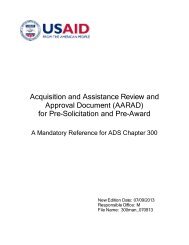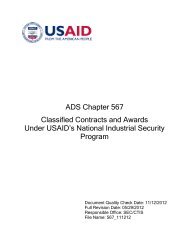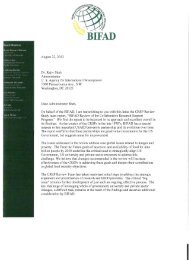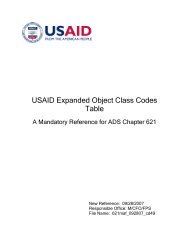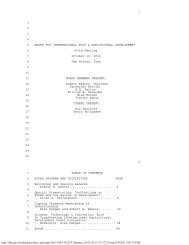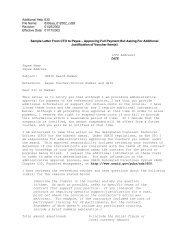USAID Policy Document - Resiliency FINAL 11-26-12.indd
USAID Policy Document - Resiliency FINAL 11-26-12.indd
USAID Policy Document - Resiliency FINAL 11-26-12.indd
- No tags were found...
Create successful ePaper yourself
Turn your PDF publications into a flip-book with our unique Google optimized e-Paper software.
Core Operational PrinciplesAs laid out by the <strong>USAID</strong> <strong>Policy</strong> Framework 20<strong>11</strong>–2015, 9 <strong>USAID</strong> also has a set of core operational principles that are being appliedacross our entire portfolio. In addition to the resilience principles, these operational principles are key considerations in ourresilience work.Promote Gender Equalityand Female EmpowermentApply Science, Technology,and InnovationResearch shows that shocks due to disasters reinforce and perpetuate gender inequality, as shockscan disproportionately affect women’s access to income, assets, and other resources. As there aresignifi cant differences in how women cope with shocks as opposed to men, 10 we will employ anapproach that reduces gaps between males and females, empowers women, and promotes inclusivegrowth.Science and technological innovations are critical in identifying vulnerabilities, improving and usingearly warning systems, and accelerating response. Innovations such as mobile money and droughtresistantcrops can play important roles in building resilience. We will promote and pilot newtechnologies and innovations in addition to scaling up proven ones.Apply Selectivityand FocusWe will ensure that our resources are strategically invested in priority regions, countries, andsubnational areas; these decisions will be made by our fi eld missions in collaboration with headquarters.We will base these decisions on criteria laid out in this paper, including levels of persistenthumanitarian assistance, chronic vulnerability, confl ict/fragility risk, <strong>USAID</strong>’s existing capacity, andthe availability and willingness of host-country partners.Measure andEvaluate ImpactWe will ensure accountability and an effective allocation of resources by informing our decisionswith evidence, data, and the fi ndings of publicly disclosed evaluations. We will also continue toimprove knowledge management in order to better catalogue and utilize those institutional lessonslearned.Build in Sustainabilityfrom the StartWe will promote ownership by strengthening the capacity of host countries to manage and lead, asno strategy imposed from the outside can bring about sustainable, positive change. Our interventionswill be tailored to those affected and the particular shock they face by incorporating localand traditional knowledge, <strong>11</strong> taking into account diverse needs and priorities, especially among themost vulnerable.Apply IntegratedApproachesIn our efforts to build resilience, we will consider humanitarian assistance in strategic planningand project design, improve coordination between humanitarian and development assistance, anddevelop budgets that recognize the interdependence of humanitarian and development assistance.We will utilize three approaches to accomplish this: layered programs across sectors and fundingstreams; integrated programming to address multidimensional challenges; and strategic sequencingof programs to maximize long-term impact.Leverage “Solution-Holders” and PartnerStrategicallyWe will promote the strategic division of labor with a wide range of partners to improve harmonizationand avoid the duplication of effort. We must collectively align with regional and nationalplans to work toward common goals, and these will best be defi ned by our country partners. Wewill work to create and sustain partnerships between humanitarian and development actors aswell as continue to work closely with our interagency colleagues and engage with a wide range ofactors, including the private sector and civil society.9 To read the <strong>USAID</strong> <strong>Policy</strong> Framework 20<strong>11</strong>–2015, visit http://transition.usaid.gov/policy/<strong>USAID</strong>_<strong>Policy</strong>Framework.PDF.10 FAO. Deriving Food Security Information from National Household Budget Surveys: Experiences, Achievements, Challenges (2008); Sibrian, R. (ed), FAO. Food SecurityInformation for Decision-Making: Measuring Resilience, Concept Note on the Resilience Tool. 2010.<strong>11</strong> Gòmez-Baggethun, E., et al. Traditional Ecological Knowledge and Community Resilience to Environmental Extremes: A Case Study in Doñana, SW Spain. Global Environ.Change (2012), doi:10.1016/j.gloenvcha.2012.02.005.17


